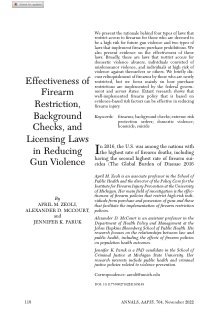By Paul M Reeping , Ariana N Gobaud , Christopher N Morrison , Charles C Branas
There have been no peer-reviewed, quantitative research studies on the effectiveness of gun-free school zones. The objective of this study was to use a cross-sectional, multi-group controlled ecological study design in St. Louis, MO city that compared the counts of crimes committed with a firearm occurring in gun-free school zones compared to a contiguous area immediately surrounding the gun-free school zone (i.e., gun-allowing zones) in 2019. Gun-free school zones were measured and analyzed in two ways. In the primary analysis, boundaries of the tax parcels were used for each school as the beginning of the gun-free school zone. Results from this analysis, after adjustment for pair-matching and confounding, were null. In the secondary analysis, gun-free school zones were measured as beginning at the geographic centroid of the school's address. After adjusting for the pair-matching and confounding, this analysis showed 13.7% significantly fewer crimes committed with a firearm in gun-free school zones compared to gun-allowing zones. These results suggest that gun-free school zones are not being targeted for firearm crime in St. Louis, MO.
J Urban Health. 2023 Dec;100(6):1118-1127. doi: 10.1007/s11524-023-00800-4. Epub 2023 Nov 14. PMID: 37964181; PMCID: PMC10728035




